- What Is High-Density
- Evolving Issues in High-Density Networks
- TP-Link Omada High-Density WiFi Solution
- What's the Difference in High-Density Design
- Why Choose TP-Link High-Density Solution
- Recommended Products
What Is High-Density
Driven by the adoption of IoT and the need for wireless by more people carrying more devices than ever before, businesses are demanding WiFi solutions that can handle significantly higher data density requirements. High-density WiFi environments are locations with hundreds or even thousands of WiFi clients. Common cases are hotel meeting rooms, lecture halls, sports stadiums, theaters, and shopping malls. High-density WiFi solutions will remain an important part of enterprise network upgrading for years to come.
Evolving Issues in High-Density Networks
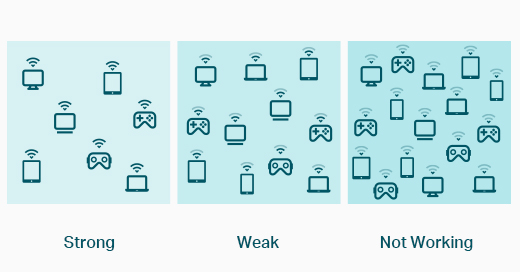
As Density Increases, Performance Deteriorates
Businesses need quality WiFi to keep employees productive and customers happy. However, a large amount of services, applications, and devices place an increasing strain on WiFi networks. Limits of WiFi capacity lead to unnecessary dropped connections and constant buffering. When data demand hits critical mass, it tends to negatively impact business productivity.
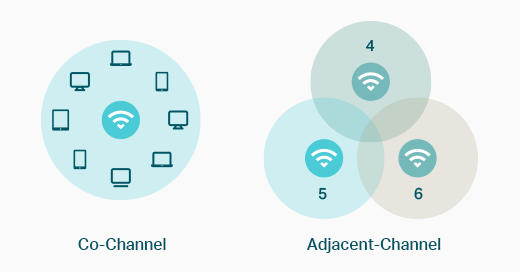
More WiFi Creates More Interference
Imaging 100 people talking in your ear on and on, how would that feel? Two reasons for poor WiFi performance are co-channel Interference (CCI)—using the same channel, and adjacent channel interference (ACI)—using separate channels but with cross-over. Massive WiFi signals can interfere with each other, creating massive issues for users in high-density locations.
TP-Link Omada High-Density WiFi Solution
TP-Link's Omada EAP Series products provide a range of capable indoor solutions designd to meet the increasing demands of high-density networks. For public locations with a high density of end users, WiFi infrastructure should be able to handle plenty of devices with stable and secure WiFi. Features such as portal authentication and multi-site management are essential for modern businesses wanting to create a customized network that suits their own needs as well as those of their customers.
Application Scenarios
- Public sites with a high volume of mobile devices require stable and uninterrupted WiFi such as airports and stadiums.
- Large campuses with multiple floors and distributed buildings require high network throughput and full WiFi coverage such as schools, hotels, and dormitories.
- Temporary sites crowded with many users and terminals such as concerts and special events.

Hospitality
High Quality and Full Coverage Wi-Fi

Restaurant
Full Wi-Fi Coverage in High-Density Environment

Shopping Mall
Social Marketing for O2O

Meeting Room
Wireless and Wired Connections for dense usage

Railway Station
High-Density Wi-Fi
Typical Topology of High-Density Network
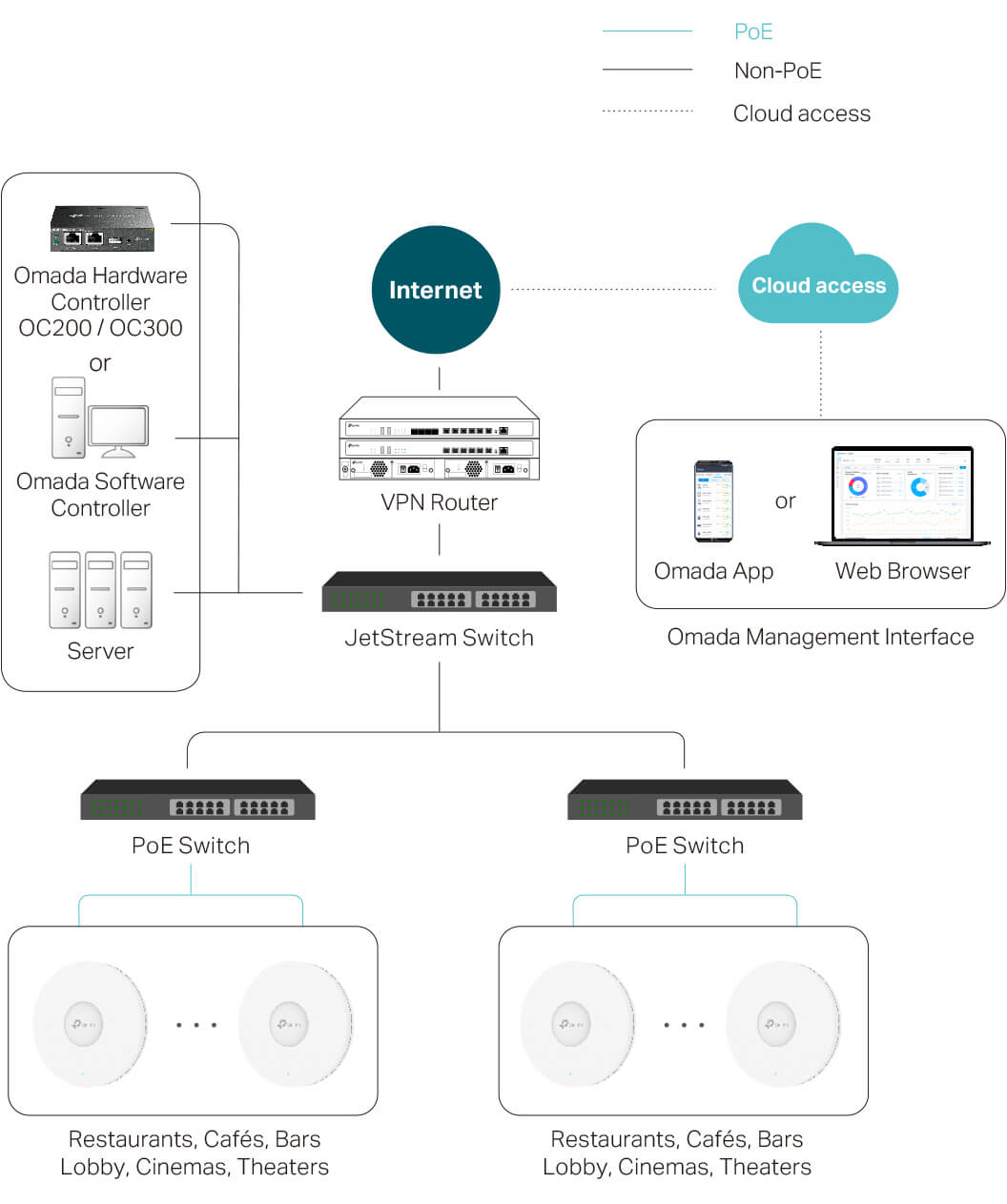
What's the Difference
How many WiFi clients can a high-density AP support?
When we are talking about performance, it is always under specific conditions. Theoretically, the high-end WiFi 6 APs like EAP660 HD are capable of supporting 300+ concurrent WiFi clients. In reality, the maximum recommended client density depends on environmental conditions.
- Comparison of Client Number between HD AP and Non-HD AP
To evaluate the improvement that a high-density AP can achieve compared to APs without HD capability, the concurrent clients simulation tests of EAP660 HD, EAP620 HD, and an AC1750 Non-High-Density WiFi 5 Access Point were conducted.
According to the results of the tests, Omada WiFi 6 HD APs greatly improve overall capacity and network quality especially when used for bandwidth-intensive activities, compared to standard WiFi 5 APs without high-density capability. Results may vary depending on the models and conditions of the client devices, as well as the network environment where the access points are deployed.
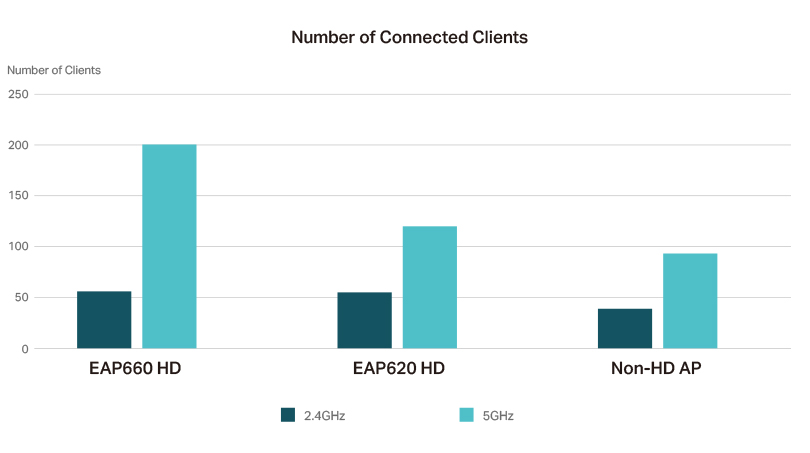
How much performance capability can a high-density AP achieve?
- Comparison of Throughput between TP-Link WiFi 6 HD AP and its Competitor
The throughput test evaluated Omada EAP660 HD’s throughput performance at different distances and its ability to penetrate walls.
With cutting-edge hardware and software design, TP-Link EAP660 HD demonstrated excellent wireless performance in most test situations. It surpassed the competitive WiFi 6 AP in both two-walled and three-walled tests. EAP660 HD is a powerful and reliable choice for businesses.
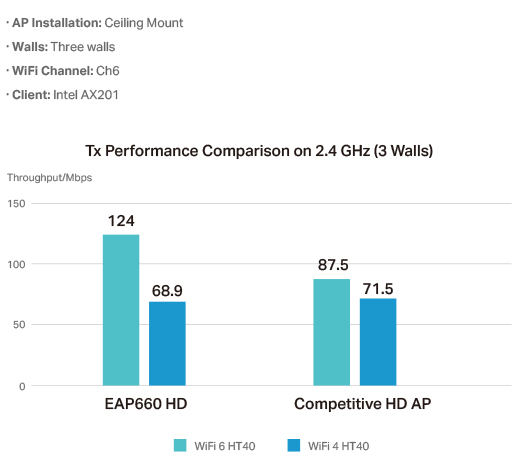
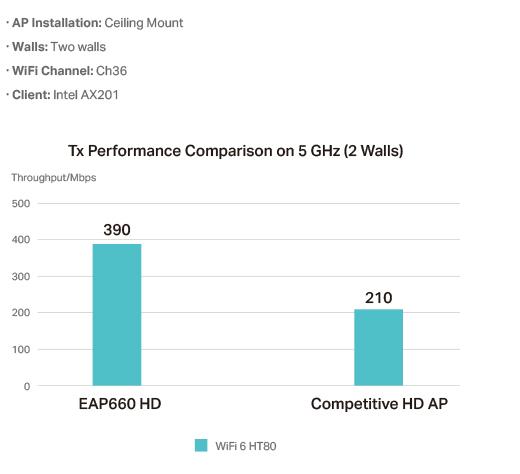
Why Choose TP-Link High-Density Solution

Larger Capacity for High-Density Environments
Omada WiFi 6 and WiFi 5 APs improve efficiency and ensure top-tier performance for high-density locations like shopping malls, supermarkets, and restaurants. The high-end WiFi 6 HD AP provides for over three hundred clients at the same time.
Seamless Roaming
Ensure customers enjoy uninterrupted streaming when moving around by switching automatically to the access points with the optimal signal.
Band Steering
With a dual-band network, client devices will be steered by the network and will be connected to the band with less traffic.
Load Balance
This feature is to balance the number of users across APs, to ensure the highest possible performance for all users.
Auto Channel Selection
To prevent overlapping channel interferences, the AP automatically adjusts the radio frequencies to avoid co-channel interferences and increase efficiency.
Omada Mesh Technology
Omada Mesh Technology enables wireless connectivity between access points for extended range, making wireless deployments more flexible and convenient.
-
Intelligent Self-Organizing
-
Self-Healing
Airtime Faireness
ATF increases efficiency and capacity across the network by preventing older devices from interfering with peak usage periods.
Full WiFi Coverage
Ceiling mount APs with professional antennas and Beamforming provide high-speed and long-range WiFi coverage for multiple scenarios.
Stable High-Speed Wired Connections
2.5 G or 1 G Ethernet port delivers exceptional multi-gigabit performance to support the insatiable demand for better and faster WiFi.
Easy Centralized Management
Centrally manage your access points, switches, gateways, and more, anywhere, anytime—all controlled from a single easy-to-use interface.
Easy Installation and Deployment
Easy mount construction and a refined, minimalist appearance. Compatibility with standard 802.3at PoE+ is ideal for flexible deployment.
Boost Business with A Customized Page
Captive Portal provides direct exposure to promotional information and other marketing content while securing network access for guests.
High-Density Product Recommendations
| Product Category | Standard | Model | WiFi Class | Ethernet Ports | Antennas | Deployment | Main Features |
| Omada Ceiling Mount Access Points | WiFi 6 | EAP660 HD | AX3600 | 1× 2.5 GE | 2.4 GHz: 4× 4 dBi 5 GHz: 4× 5 dBi |
Lobby / Supermarket / Restaurant / Bars |
|
| EAP620 HD | AX1800 | 1× GE | 2.4 GHz: 2× 4 dBi 5 GHz: 2× 5 dBi |
Lobby / Supermarket / Restaurant / Bars |
|
||
| WiFi 5 | EAP265 HD | AC1750 | 2× GE | 2.4 GHz: 3× 3.5 dBi 5 GHz: 3× 4 dBi |
Restaurant / Café / Bars |
|
*Omada Mesh and Fast Roaming require the use of Omada Controllers. Use of Mesh may require further software upgrades.
**Zero-Touch Provisioning is supported when using Omada Cloud-Based Controller.
Powerful Support
Zdobądź Rozwiązania i Produkty dzięki Programowi Partnerskiemu
Sukces TP-Link’a jako dostawcy rozwiązań sieciowych został zbudowany na niezrównanych relacjach z partnerami. Dla Resellerów (VAR) i Integratorów systemów (SI) szukających dostępu do coraz lepszych ofert i wsparcia z doświadczeniem, TP-Link stworzył program TP-Link Partner, aby pomóc w rozwoju firm.
z United States?
Uzyskaj produkty, wydarzenia i usługi przeznaczone dla Twojego regionu.




